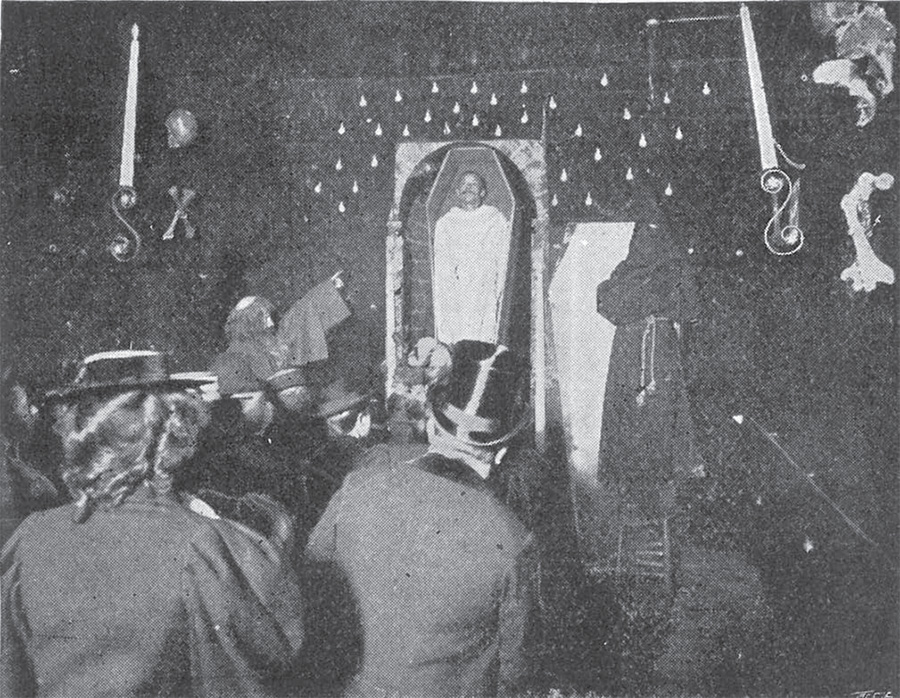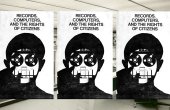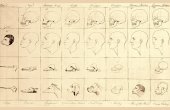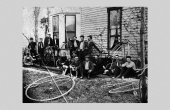Inside the Death-Themed “Cabaret of Nothingness”

From 1892 until 1954, three cabaret-restaurants in the Montmartre district of Paris captivated tourists with their grotesque portrayals of death in the afterworlds of Hell, Heaven, and Nothingness. Each had specialized cuisines and morbid visual displays with flashes of nudity and shocking optical illusions. These cabarets were considered the most curious and widely featured amusements in the city. Entrepreneurs even hawked graphic postcards of their ironic spectacles and otherworldly interiors.
In his book “Cabarets of Death” (Strange Attractor Press), Mel Gordon (1947–2018) documents the dinner shows, character interactions with guests, and theatrical goings-on in these unique establishments. The excerpt that follows is part of a longer chapter on the Cabaret du Néant, the “Cabaret of Nothingness.”
Early in 1892, Antonin Dorville established the Café de la Mort in Brussels. An illusionist who designed “Black Art” projections for itinerant magic stage shows, Dorville combined the notion of a restaurant as a mortuary with an adjoining room that cast animated facsimiles of decaying human flesh and ghostly apparitions. His sensational locale proved to be a lucrative enterprise, but after a few months, he moved it to 53 Boulevard de Clichy in Paris, renaming it the Cabaret du Néant, the “Cabaret of Nothingness.”

Dorville’s novel import flourished and, in June 1895, he transferred his commercial undertaking across the street to 34, Boulevard de Clichy, where he added several darkened rooms. It remained in place until 1956. With Cabaret du Néant’s phenomenal growth and playful notoriety came savage criticism from indigenous reviewers, who disparaged its mocking tenor as “morbid and neurotic.” Tourists and out-of-towners, relying on word-of-mouth communication, however, flocked to it.
On January 18th, 1896, a replica of the Néant opened in the Casino Chambers on 39th Street and Broadway in New York City. Eschewing its French culinary setting, the Manhattan Néant offered 30-minute walk-throughs from 8 pm to midnight for 25 cents. Besides ambulant and disarticulated skeletons, spectators could marvel at the sleight-of-hand projections of blank-faced cadavers and graveyard phantoms. Included in this “Parisian sensation” was the first public exhibition of an X-Ray Machine in North America.
With its phenomenal growth came savage criticism from reviewers, who disparaged its mocking tenor as “morbid and neurotic.”
Two months later, Albert A. Hopkins published an illustrated exposé of the Néant’s mirror and plate glass optical tricks in Scientific American. They were all variations of an ingenious technique known as “Pepper’s Ghost.” Imitations of the Broadway Néant appeared at New England carnivals and fairs around Halloween for several years.
Although French academics and intellectuals generally ignored the Cabaret du Néant in Montmartre, the Surrealists, led by André Breton, conducted sleep experiments in the floor above the restaurant-nightclub in 1920.
CABARET DU NÉANT
Boulevard de Clichy / 1892 – 1946
AREA
18th ARRONDISSEMENT, Montmartre.
Directly across from the Cabarets du Ciel et L’Enfer.
ATMOSPHERE
Even more droll and macabre than L’Enfer: a grisly caricature of Eternal Nothingness. A black-caped croquemort, or pall-bearer, ushers in the curious diners through a side door. The black draping and grotesque positioning of the skeletons on the walls suggest the aftermath of a frightful catastrophe or a dismembering station in a charnelhouse. A distinct odor of death hovers.
CLIENTELE
Foreign tourists, especially Germans, who are addressed as “Brother and Sister Coffin-Worms.” French provincial couples are sometimes called Maccabées (sailor slang for the lifeless bodies found floating in riverbeds).
DÉCOR
A dim “Room of Incineration” is lighted with wax tapers and a large chandelier devised of three human skulls (including an infant’s) and fleshless fingers holding funeral candles. Large, heavy wooden coffins, resting on biers, are set about the room as dining tables. White skulls rest on the coffin-tops. Guests are handed tapers that eerily illuminate their faces when they order.
ENTERTAINMENT
A black-frocked cleric, holding a human leg-bone, reminds the “Coffin-Worms” of their impending doom and reels off the incredible varieties of dissolution that the Grim Reaper has planned for them. While he pontificates about their painful demises, glowing panels of frolicking men and music-hall dancers divulge their worldly futures as hideous skeletal remains. Other objets d’art include a bleeding neck from a guillotined victim and a laughing skull that flies through the air. After this, the monkish MC invites the revelers (for one franc) into the “Tomb of Death.” There, in a pitch-dark chamber, the candle-holding patrons watch figures pour out of an upright coffin while a harmonium wheezes an off-key funeral march. One of them is a rosy-faced femme who magically decomposes into a bald and fleshless corpse as she bewails her agonizing fate. Afterwards, a few audience members are led into the trick stage box, transformed visually into their imminent future as emaciated cadavers before their friends, and then restored to their stocky selves. The whole thing lasts about 30 minutes.
EROTIC ENTICEMENT
In a third dank room (another franc, merci), the Graveyard, a female spectator is coerced into sitting in a chair inside another upright coffin. Without any warning, her outer garments seem to vanish and, through a mirror projection, she is made to appear in provocative and revealing underclothing. Of course, the female Worm is unaware of this immodest transformation and blankly stares back at her delighted audience.
FOOD
The morbidly slow waiters are dressed as top-hatted hearse-followers and describe each drink as a deadly contagion: A glass of bock beer is referred to as one microbe of Asiatic cholera; cherry liquor as a malignant cancer; crème de menthe as a dose of TB.
UNUSUAL
When the crowd files out of the Tomb of Death, they are encouraged to drop coins into an inverted skull, which will ensure them of a longer life on this earth.
ALCOHOLIC DRINKS
Absinthe— “the juice of crushed maggots”
Glass of Alsatian bock beer— “foam from Asiatic cholera germs”
Glass of lager beer— “glass of strychnine”
Cerises à l’eau-de-vie (cherries in alcohol)— “bone marrow from a corpse who died of malignant cancer”
Crème de menthe— “sputum from a TB victim”
Rum cocktail— “pall bearer”
Vermouth— “shot of cholera”
Glass of château la pompe wine— “glass of funeral Parlor”

HORS-D’OEUVRE
Oysters from Ostend— “soft-boned oysters”
FISH
Fish in sauce— “weeping willow”
ENTREÉS— “EXHUMED”
Roast lamb— “tranquility”
Italian macaroni— “one word from cambronne” (shit)
Ox tripe from Lyons— “two death knell tolls”
Cooked potatoes in their skins— “man underground”
Sandwich— “sighs of the dying”
ASSORTED DESSERTS— “ASSORTED DEATHS”
Plate of brie— “pray for him”
Fruit cup— “a hearse”











Mel Gordon (1947–2018), called a “drama scholar of the fringe” by the New York Times, published books on the grisly Grand Guignol theater, the deviant sexual worlds of Weimar Berlin and Paris, and Hitler’s Jewish clairvoyant. This article is excerpted from his book “Cabarets of Death,” edited by Joanna Ebenstein.



